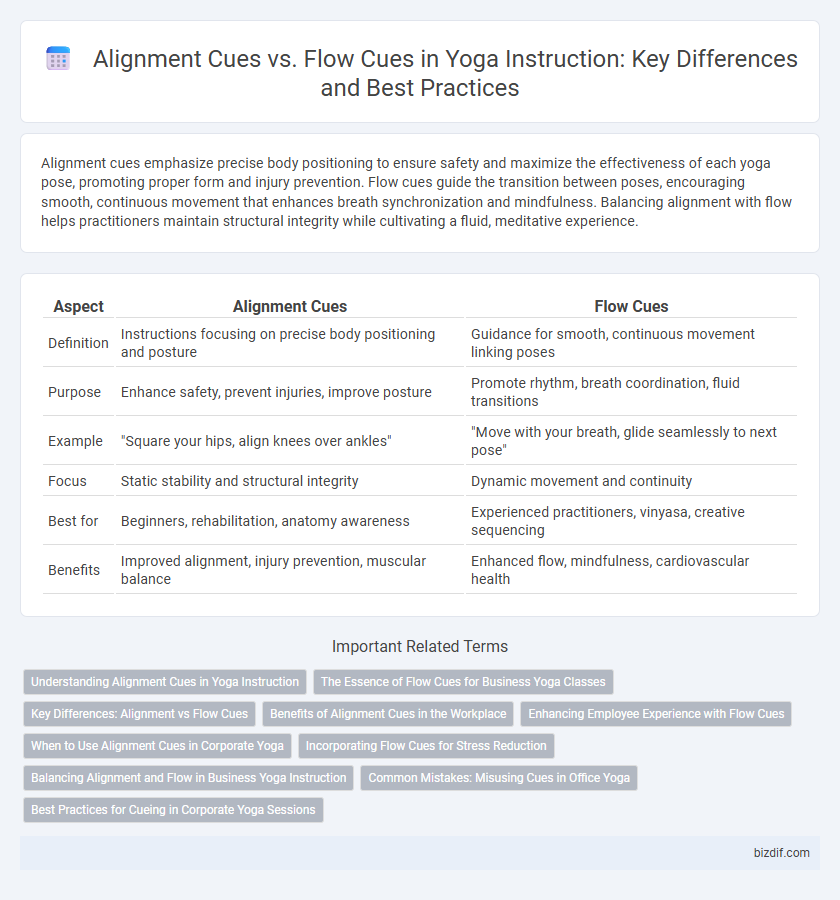Alignment cues emphasize precise body positioning to ensure safety and maximize the effectiveness of each yoga pose, promoting proper form and injury prevention. Flow cues guide the transition between poses, encouraging smooth, continuous movement that enhances breath synchronization and mindfulness. Balancing alignment with flow helps practitioners maintain structural integrity while cultivating a fluid, meditative experience.
Table of Comparison
| Aspect | Alignment Cues | Flow Cues |
|---|---|---|
| Definition | Instructions focusing on precise body positioning and posture | Guidance for smooth, continuous movement linking poses |
| Purpose | Enhance safety, prevent injuries, improve posture | Promote rhythm, breath coordination, fluid transitions |
| Example | "Square your hips, align knees over ankles" | "Move with your breath, glide seamlessly to next pose" |
| Focus | Static stability and structural integrity | Dynamic movement and continuity |
| Best for | Beginners, rehabilitation, anatomy awareness | Experienced practitioners, vinyasa, creative sequencing |
| Benefits | Improved alignment, injury prevention, muscular balance | Enhanced flow, mindfulness, cardiovascular health |
Understanding Alignment Cues in Yoga Instruction
Alignment cues in yoga instruction emphasize precise body positioning to enhance safety and effectiveness, targeting joint stability and muscular engagement. These cues help practitioners develop kinesthetic awareness, preventing injury by maintaining optimal anatomical form during poses. Mastery of alignment cues supports deepening practice and improving overall biomechanical efficiency in yoga sequences.
The Essence of Flow Cues for Business Yoga Classes
Flow cues in business yoga classes emphasize smooth transitions and rhythmic movement, fostering mindfulness and stress relief essential for corporate wellness. Unlike alignment cues that prioritize precise posture, flow cues enhance overall body awareness and adaptability, catering to busy professionals seeking mental clarity. This approach cultivates a balanced practice that improves focus and energy, directly benefiting workplace productivity and employee well-being.
Key Differences: Alignment vs Flow Cues
Alignment cues emphasize precise body positioning, joint stacking, and muscle engagement to ensure safety and anatomical integrity during yoga practice. Flow cues prioritize breath synchronization and smooth movement transitions, promoting fluidity and continuous motion throughout the sequence. Differentiating these cues helps instructors tailor classes to either enhance structural stability or encourage dynamic energy flow.
Benefits of Alignment Cues in the Workplace
Alignment cues in yoga instruction enhance workplace well-being by promoting better posture and reducing musculoskeletal strain during desk work. Emphasizing precise body positioning improves employee focus, reduces injury risk, and encourages mindful movement throughout the day. These benefits contribute to increased productivity and overall physical health in a corporate environment.
Enhancing Employee Experience with Flow Cues
Flow cues in yoga instruction enhance employee experience by promoting seamless transitions and maintaining energy throughout the practice, which boosts engagement and reduces fatigue. Unlike alignment cues that focus on precise body positioning, flow cues encourage mindfulness and rhythm, fostering a more holistic workout environment. This approach supports employee well-being by integrating movement with breath, improving focus and overall satisfaction during workplace wellness programs.
When to Use Alignment Cues in Corporate Yoga
Alignment cues should be prioritized in corporate yoga sessions to ensure participant safety and prevent injury, especially for beginners or those with limited flexibility. Clear, specific alignment instructions enhance body awareness and promote correct posture during poses, which is crucial in environments where individuals may have varied levels of experience. Emphasizing alignment in these settings supports long-term physical health and maximizes the benefits of the practice.
Incorporating Flow Cues for Stress Reduction
Incorporating flow cues into yoga practice enhances smooth transitions between poses, which promotes relaxation and reduces cortisol levels linked to stress. Emphasizing rhythmic breathing and continuous movement helps maintain mindfulness and cardiovascular calm, supporting overall mental well-being. This approach shifts focus from rigid alignment to experiential flow, optimizing stress relief benefits in yoga sessions.
Balancing Alignment and Flow in Business Yoga Instruction
Balancing alignment and flow cues in business yoga instruction improves practitioner safety and engagement by emphasizing precise body positioning alongside smooth, continuous movement. Alignment cues guide students to maintain correct posture, preventing injuries, while flow cues encourage rhythm and breath synchronization, enhancing relaxation and mindfulness. Integrating both strategies fosters a holistic practice that meets diverse client needs and promotes sustainable well-being in corporate wellness programs.
Common Mistakes: Misusing Cues in Office Yoga
Misusing alignment cues in office yoga often leads to rigidity and discomfort, while unclear flow cues can disrupt the natural movement rhythm and reduce practice effectiveness. Common mistakes include overemphasizing perfect postural alignment without accommodating individual body variations, causing strain or injury. Effective yoga instruction balances precise alignment with smooth transitions to ensure safe, fluid movements tailored to office workers' needs.
Best Practices for Cueing in Corporate Yoga Sessions
Alignment cues emphasize precise body positioning to enhance safety and prevent injury during corporate yoga sessions, promoting muscular balance and joint health. Flow cues guide smooth transitions between poses, fostering relaxation and maintaining rhythm to reduce workplace stress effectively. Integrating both cueing styles, while tailoring instruction to participants' experience and physical conditions, optimizes engagement and maximizes the therapeutic benefits in a corporate environment.
Alignment cues vs Flow cues Infographic

 bizdif.com
bizdif.com